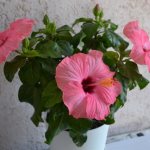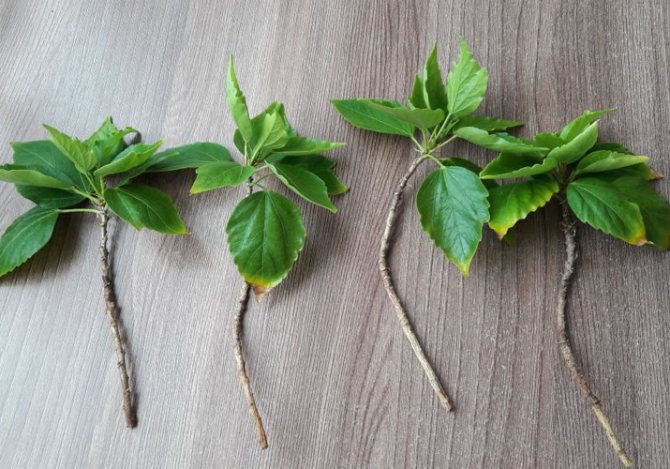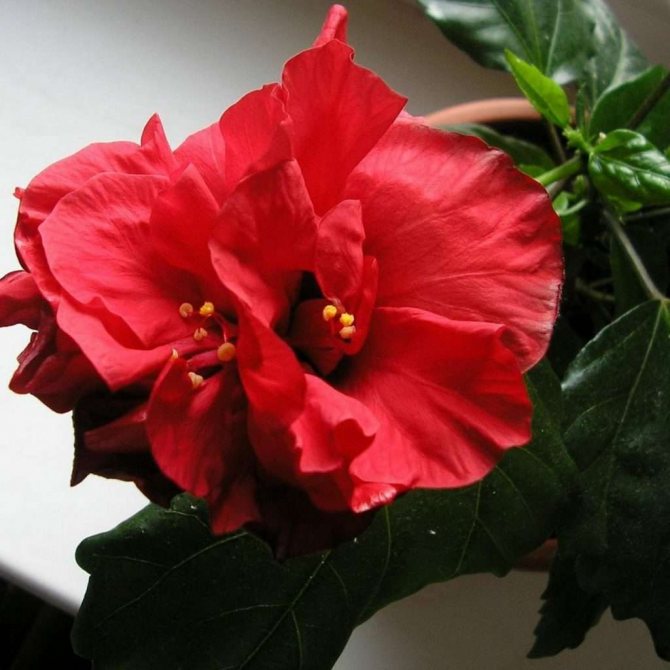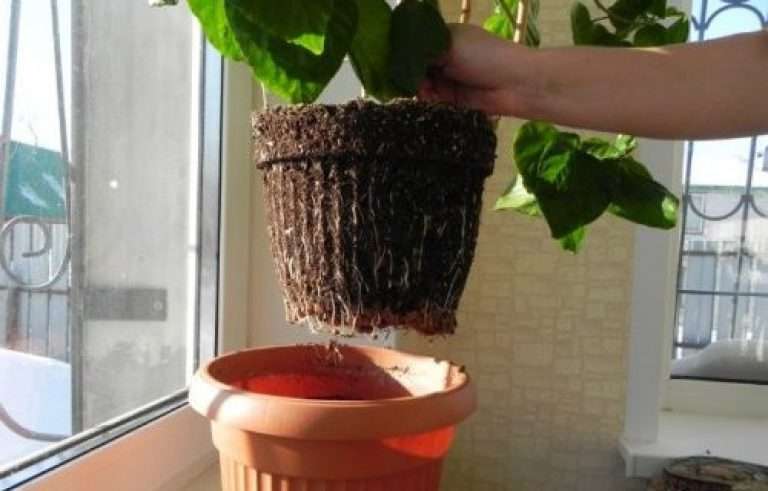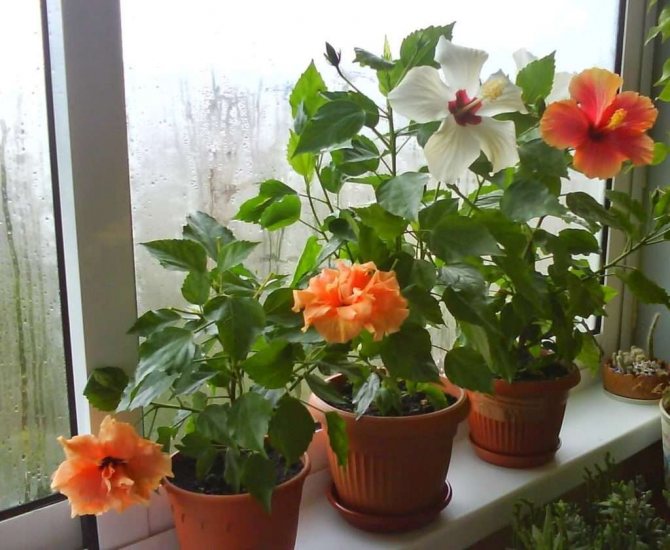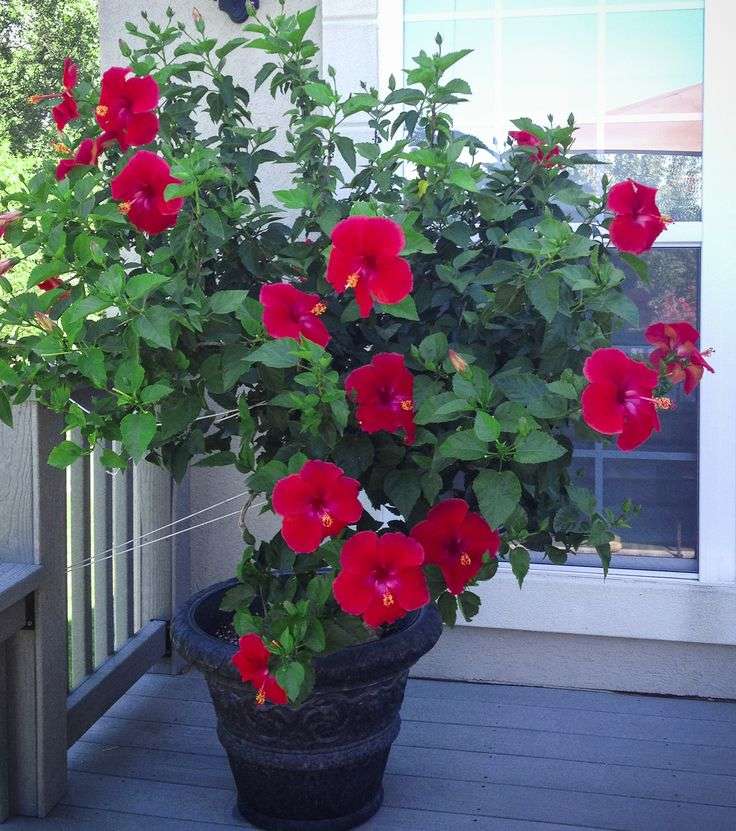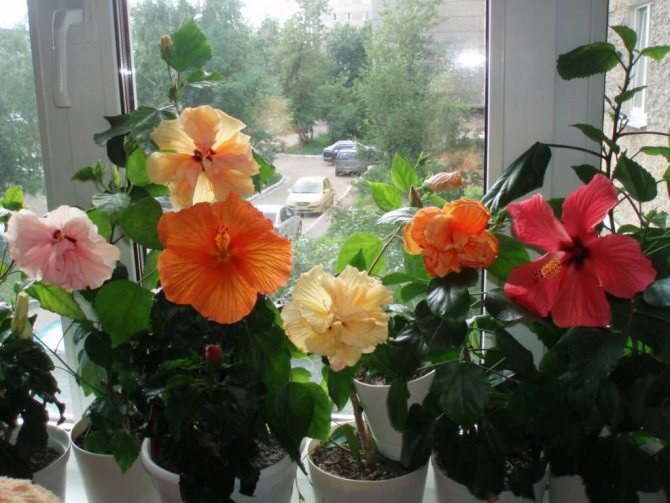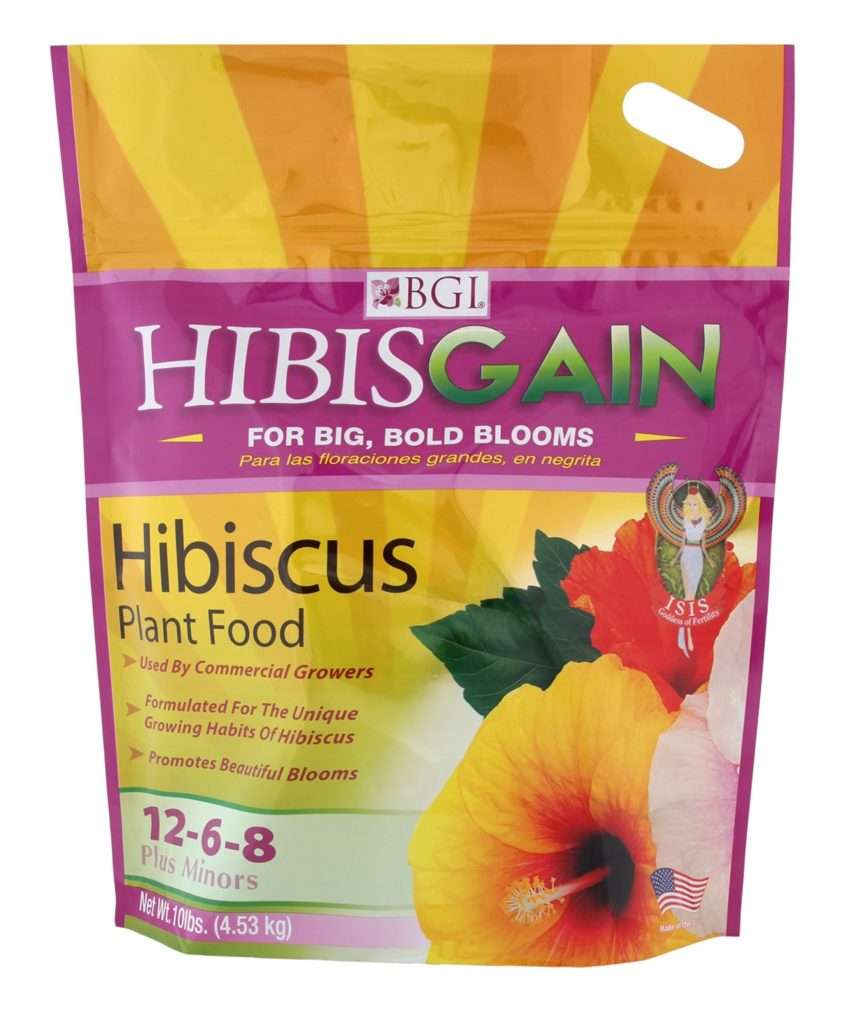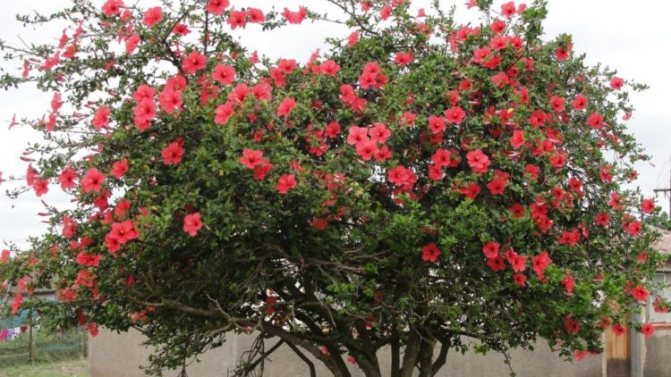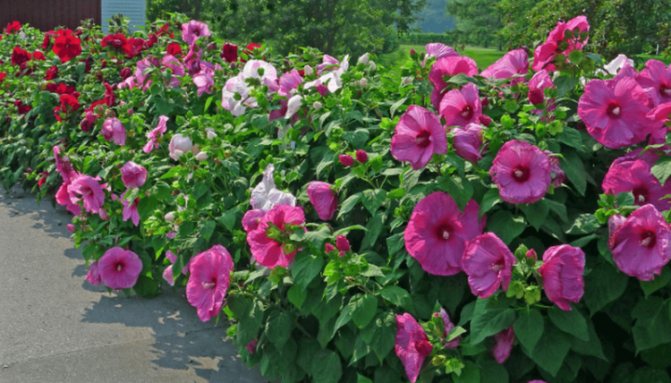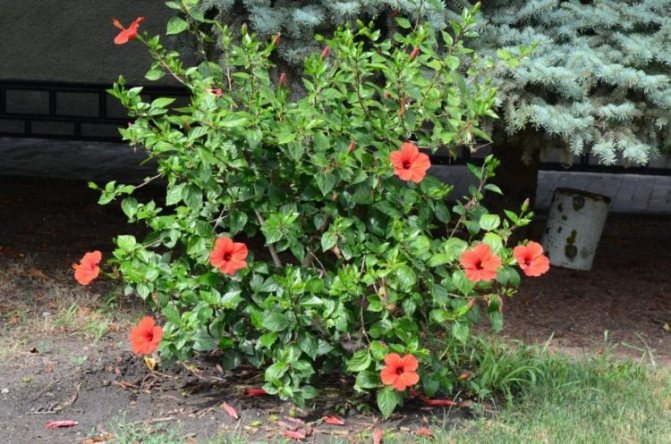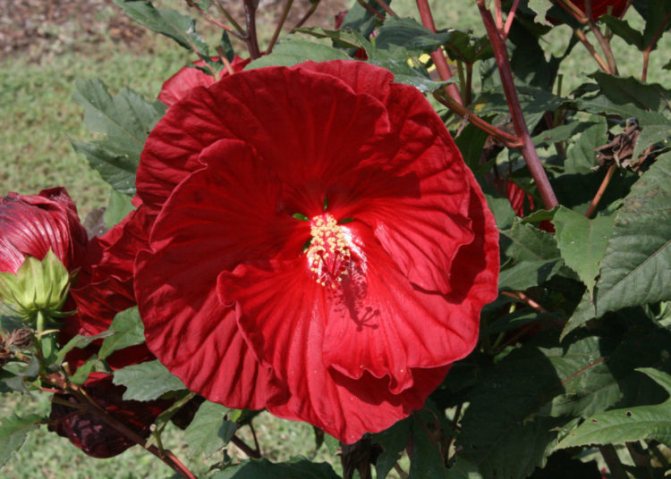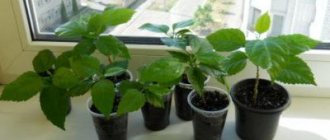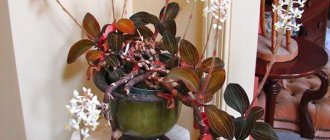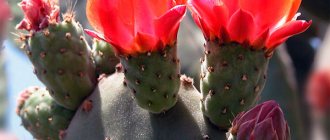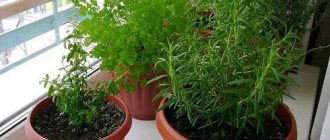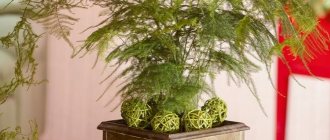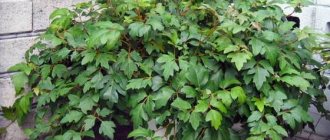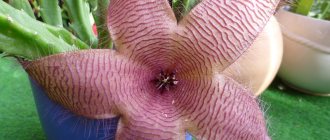Hibiscus is a very popular and incredibly beautiful flower that is successfully grown both in the garden and indoors. The genus "Hibiscus" belongs to the family "Malvovye" and has more than two hundred species and varieties. Not many people know that it is from the petals of one of the types of hibiscus, called "Sudanese Rose", that "Hibiscus" tea is made. But the Sudanese rose is grown only in the garden, and at home another type of plant has taken root - "Chinese Hibiscus" or "Chinese Rose". Today we will talk about taking care of the indoor type of hibiscus at home.
Description
Indoor hibiscus is a tree-like shrub that grows up to 3 meters. It has lush foliage of rich green color. The leaves are shiny and serrated.
In the tropics, hibiscus can bloom all year round, but at home it blooms from spring to autumn in large, cup-like flowers. Each individual flower lives for 1-2 days, after which it gradually begins to fade. But on each bush of the Chinese rose there are usually a lot of buds, so its decorative effect does not suffer from this. The color of the petals and their shape are very diverse depending on the variety.
When pollinated, fruits appear that look like a five-leafed capsule. Inside are seeds, which can be either smooth or covered with hairs.
Diseases and pests
With improper care, the Chinese rose is subject to the following diseases:
- falling leaves;
- lack of flowers on the shrub;
- the appearance of spots of various colors on the leaves;
- lethargic or dry leaves;
- dying off of shoots.
The most common tea rose pests are:
- spider mite;
- aphid;
- whitefly;
- thrips.
One of the important points when caring for hibiscus is also airing the apartment. The plant needs Fresh air, but drafts should not be allowed, as buds that have not yet opened may fall off.
You can read more about hibiscus diseases and how to deal with them here.
Chinese hibiscus varieties
More than 500 hybrid varieties of Chinese hibiscus have been developed, which differ from each other in the shape of flowers and color. The photo shows the most popular of them.
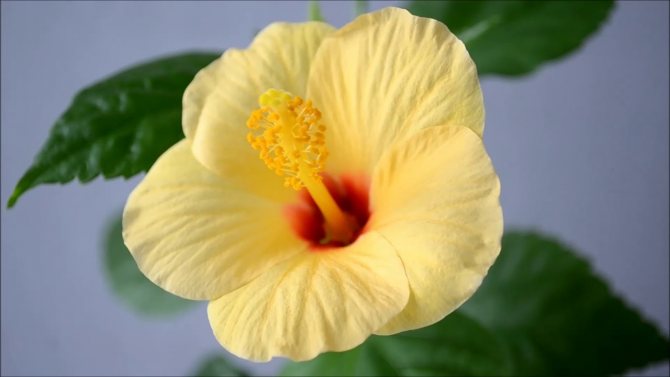
Kyoto - yellow flowers with a reddish center.
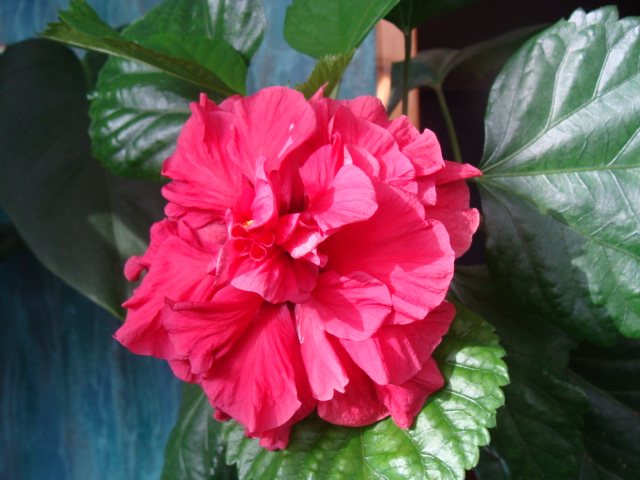

Hamburg - purple double flowers.
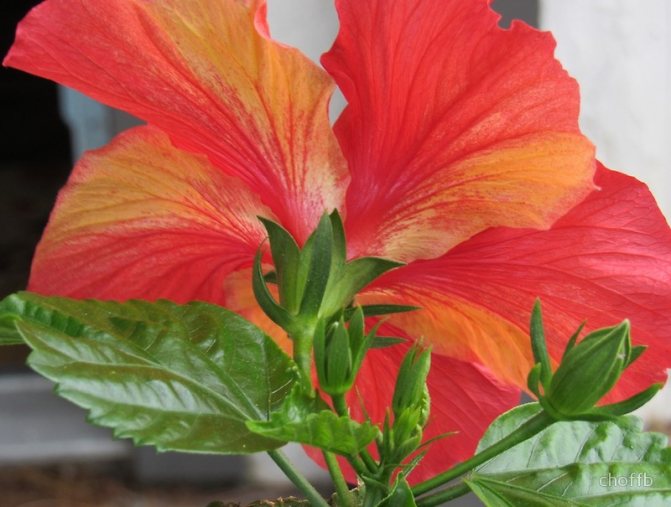

Florida - red-orange petals.
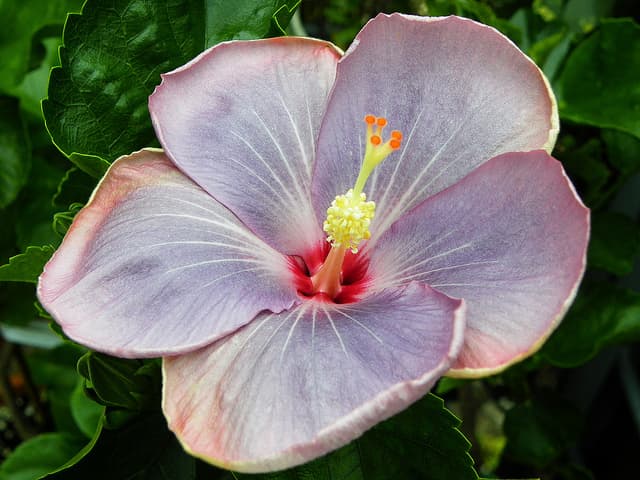

Feeling Blue - Flowers of bluish-purple shades are diluted with thin white stripes drawn from the center to the edges. A very decorative variety.
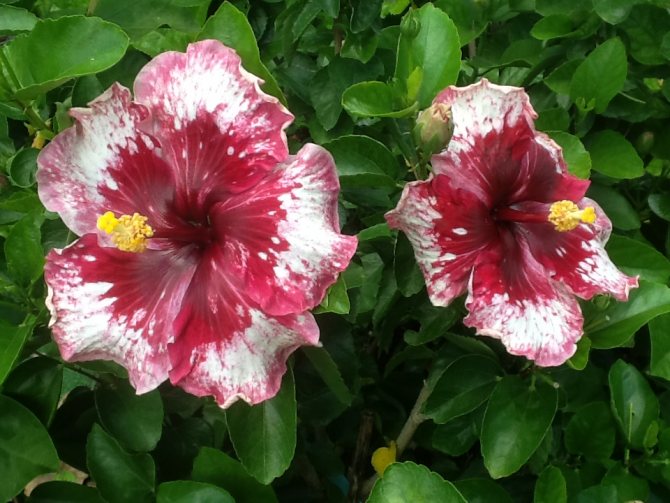

Pirple majestic - dark burgundy flowers with white specks appearing closer to the edges of the petals.
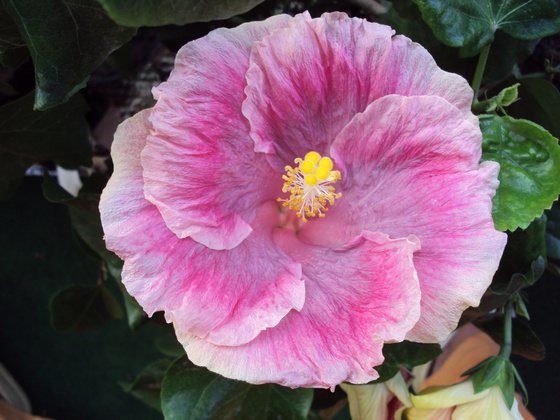

Carmen Keene - pale pink flowers with a white border.


San Remo - rather large white flowers with a yellow pistil.
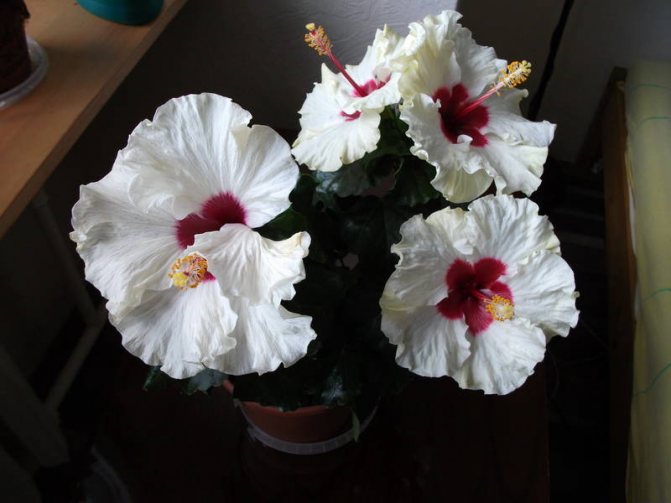

Borias - white flowers with wavy edges. The core is bright crimson.
Features of a plant, photo of a flower
Unlike indoor representatives, garden hibiscus is able to withstand low temperatures, is picky about regular loosening of the soil and the removal of weeds growing nearby.
Hibiscus care at home
Growing hibiscus at home will take a lot of patience.But this is not due to the fact that the flower is too picky about the conditions of detention. It's just that the Chinese rose is slowly growing. It will take several years for a young specimen bought in a store or planted on its own to turn into a large, lush, profusely flowering bush. Perhaps this is the only difficulty, because otherwise, hibiscus, like most tropical plants, loves bright lighting, abundant watering and high humidity.
Lighting and location
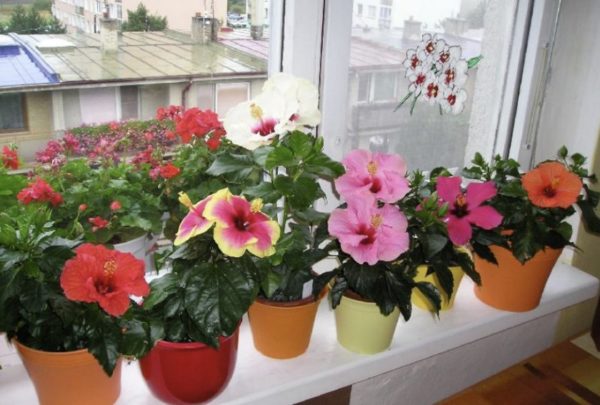

Hibiscus needs a lot of sunlight. If you plan to grow a flower on a windowsill, the most successful options would be east and west windows. A southern window sill can also be used, but at noon, the hibiscus should be shaded with curtains or blinds to prevent the leaves and buds from burning. If you plan to place a pot with a plant in the back of the room, choose the south side, as otherwise it will not have enough light. In the northern regions, where cloudy weather or short daylight hours prevail, additional illumination with phytolamps is required.
Hibiscus doesn't like drafts. Remove the flower while airing the room, and also do not place it near an open window.
In summer, a pot with a Chinese rose can be taken out to a balcony, loggia or garden. Fresh air promotes more abundant flowering. But protect the flower from the wind, as well as from prolonged exposure to the midday sun. Hibiscus tolerates morning and evening sunlight well, but can wither from the midday sun.
It might be interesting: Clerodendrum - home care
In winter, it is better to rearrange the plant on the sill of the south window. It is desirable to provide additional artificial lighting.
Temperature
In spring and autumn, the optimum temperature for hibiscus is 20-22 ° C. In summer it can be raised to 25 ° C. In winter, it is recommended to lower the temperature to 15-18 ° C, as this has a positive effect on the setting of buds and the flowering of hibiscus in the next season. But in no case do not let the temperature drop below 12 ° C - the flower may die.
If you don't have a cold room at home, don't worry, hibiscus can overwinter at normal room temperature.
Watering


Hibiscus is a moisture-loving plant. In spring and summer, it should be watered abundantly so that the entire earthen lump is completely saturated with moisture. But this should not be done too often, between waterings the top layer of the soil should dry out. In autumn and winter, watering is slightly reduced, and watered 2-3 days after the top layer dries. For irrigation, settled, filtered, rain or melt water at room temperature is used.
Hibiscus is not able to accumulate water in the leaves, so you should not forget about watering it. If you were still away and did not water your pet for a long time, you need to bathe it in the shower immediately upon returning. So the plant will be saturated with moisture faster than through the roots, and, most likely, will not get sick.
Air humidity
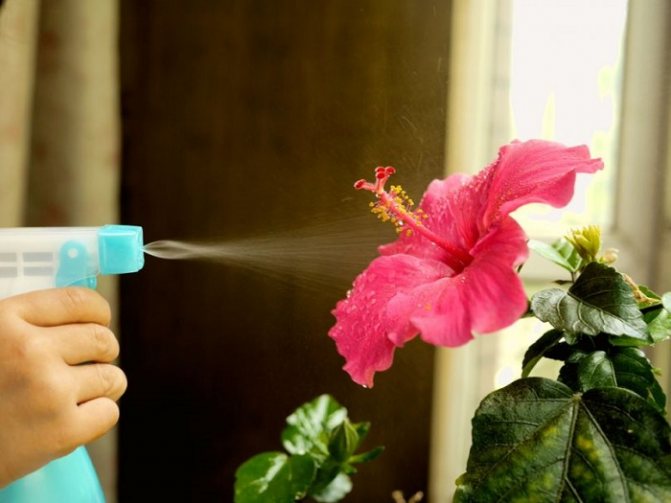

The Chinese rose needs high humidity, otherwise there is a possibility that the buds will not open completely. Therefore, it should be sprayed frequently. Use the same water for spraying as for irrigation. At the same time, be extremely careful - try to spray only the leaves of the plant, not getting on the buds, otherwise they will be covered with spots and fall off. A good bonus would be the presence of an aquarium or a humidifier in the room.
In winter, special attention should be paid to humidity, because during the heating season the air in our apartments becomes very dry. Try not to place the flower pot near the central heating radiator, and if this is not possible, cover the radiator with a damp towel. Remember to dampen the towel as it dries.Additional air humidification can be organized using a tray filled with water and pebbles (expanded clay). But please note that the bottom of the hibiscus pot should not touch the water, otherwise the roots can rot from excess moisture.
Top dressing
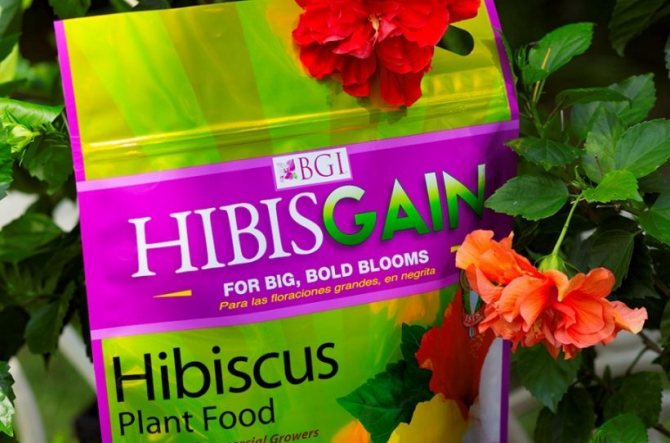

Like any other houseplant, hibiscus needs additional feeding, because the nutrients in the soil are not endless. In the spring, when the flower is actively growing and gaining buds, feed it with liquid fertilizers containing nitrogen, iron and copper. During flowering, the composition of the dressings should be changed, and fertilizers containing phosphorus and potassium should be used. Potassium assists in bud formation and phosphorus assists in root growth. Feed the flower 2-3 times a month, no more. Follow the dosage according to the instructions.
Some resources do not recommend using fertilizers containing nitrogen, as hibiscus does not like it. But in order for your bush to grow and grow lush foliage, nitrogen is needed. Therefore, we, in turn, advise you not to worry about this, and apply nitrogen-containing fertilizers during the period of active growth. Above all, do not overdo it. Apply such dressings no more than 3 times a month.
There are a couple of rules to follow when feeding hibiscus:
- before feeding, the flower should be watered abundantly;
- Fertilizers are best applied in the evening.
It may be interesting: Indoor calceolaria - growing from seeds and care
The frequency of top dressing in winter depends on the temperature at which your bush hibernates. If you were able to provide him with a cool wintering with a temperature of 15-18 degrees, stop feeding. If you couldn't, just reduce them to 1 time per month.
Pruning indoor hibiscus
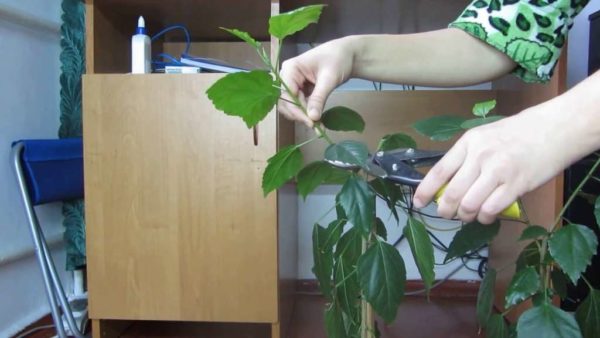

You need to know that buds are formed only on young branches of a Chinese rose, and pruning is necessary for their appearance. After the flowering period, trim the tips of all the shoots. This stimulates the emergence of new lateral shoots in these places, on which buds will appear next year. In early spring, also pinch all the shoots, including the young ones that have appeared.
Pruning for decorative purposes is also necessary. Remove shoots that grow parallel to the main trunk (tops) and those that grow into the crown. Do not worry about the flower, it tolerates pruning well and never gets sick after it.
Lighting
The Chinese rose prefers good lighting, but without the bright rays of the sun.
The most suitable place for hibiscus is windows facing west or east.
It can also grow on southern windowsills, but in this case, shading will be needed at noon, which can be created using translucent paper or fabric.
In winter, additional lighting can be arranged using fluorescent lamps. Backlight time - at least 8 hours a day. The lamp should be placed 50 cm above the plant.
In low light, hibiscus will bloom little or not at all.
Keeping hibiscus in winter in cool conditions has a positive effect on its decorative effect. In the cold season, when daylight hours are short, such conditions will slow down the growth of young shoots and thus prevent the plant from stretching.
The room where the hibiscus is located is recommended to be regularly ventilated.
Loading ...
How to transplant hibiscus
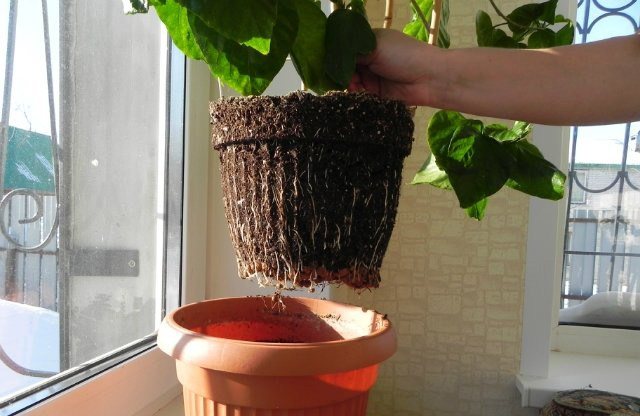

The first transplant of indoor hibiscus must be carried out a couple of weeks after purchase. Stores use a depleted substrate so that the plant does not grow too much while on the counter. But if you bought a flowering specimen, wait until the end of flowering, otherwise all the flowers will fall off. Further, young specimens less than 3 years old are transplanted once a year in early spring, slightly increasing the diameter of the pot.Older specimens are transplanted every 2-3 years, and adult large bushes are no longer transplanted at all. It is enough to renew the topsoil.
Pot
Each time the new pot should be slightly larger than the previous one. But you cannot immediately take too large a container, otherwise the plant will put all its strength into the growth of roots and foliage, leaving you without colorful flowering this year. The diameter of the pot should be increased until it reaches 30-40 cm. In the future, new pots are not used, and the transplant can be carried out in the same pot. Otherwise, you will grow a rather large bush at home and will face the problem of placing it.
The soil
For indoor hibiscus, loose soil with neutral acidity is suitable. The easiest way is to buy ready-made soil for hibiscus in the store. If this is not found, you can prepare the mixture yourself:
- Buy a universal soil for indoor plants and dilute it with an equal part of garden soil with the addition of moss.
- Mix the same universal soil with turf soil and humus in equal proportions. Add some charcoal.
- Mix 2 parts of humus or rotted compost, 1 part of leafy soil, 1 part of sand or vermiculite.
Transplant process
- Stretch out the pot and cooked soil.
- Place a thick layer of drainage and some soil at the bottom of the pot.
- Remove the hibiscus from the old pot along with the earthy clod. Shake off the dirt ball a little, but not completely.
- Examine the roots carefully. If you find rotten roots, cut them off.
- Place the bush in the center of the new pot and sprinkle dirt between the earthy ball and the walls. In the process, shake the pot a little so that the earth falls asleep in hard-to-reach places and settles a little. Add some earth and on top, compacting slightly.
- Water and spray well with the hibiscus.
- Return the bush to its old place. The plant does not like moving, and even more so after transplanting it does not need extra stress.
The soil
Hibiscus prefers light, nutritious, neutral soil (pH 6). Possible soil options for indoor hibiscus:
- Leafy land, sod land, humus, sand (3: 4: 1: 1);
- Sod land, humus, sand (2: 1: 1);
- Leafy, sod land, humus, sand, peat (1: 1: 1: 1: 1).
Place drainage on the bottom of the hibiscus pot, for example, expanded clay or broken shards. This will save the flower from stagnant water.
If it is not possible to prepare the soil mixture yourself, a purchased substrate for roses or begonias is suitable for hibiscus. It is desirable to add a small amount of loosening components to store mixes, for example, sand and / and perlite. Thanks to them, the air and moisture permeability of the soil increases. You can not add not rotted manure or dry mullein.
It is recommended to add a little crushed charcoal and bone meal to the finished mixture.... This will help to avoid stagnation of water in the soil and the appearance of various rot.
Reproduction of hibiscus
Chinese hibiscus can be propagated at home by cuttings and seeds. Seed propagation is a rather laborious process, and is more often used by breeders. With this method of propagation, there is no guarantee that the varietal characteristics of the mother plant will be preserved. In addition, the first flowering will have to wait for several years.
Propagation by cuttings at home
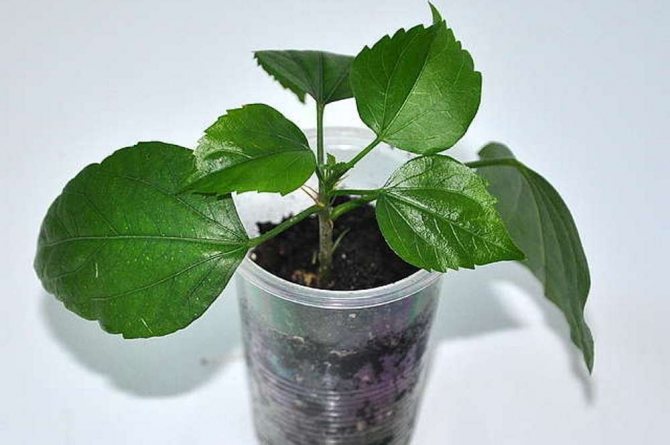

Cutting is the simplest and most common way to propagate indoor hibiscus. A specimen grown from a cutting retains all the varietal characteristics of the mother plant. In addition, flowering can be expected already in the first year. Cutting is best done in the fall, after flowering.
- Cut the cuttings 10-12 cm long with 3-4 internodes from even, undeformed branches of the mother bush.
- Trim the bottom leaves and flowers.
- Prepare a potting mix of equal parts peat and sand. Fill it in cups or other containers suitable for rooting cuttings. Place the cuttings there.
- Create greenhouse conditions for them by covering with a film, a transparent bag or glass.
- Place the greenhouse in a room with an air temperature of 25-27 degrees, ventilate and humidify daily.
- The stalk will take root in about a month. When this happens, transplant the young specimens into 7cm diameter pots, trim the top off, and care for them as if they were an adult plant. Most likely, your new specimen will lay buds already in the spring.
It may be interesting: Anthurium: indoor flower pests and the fight against them at home
Hibiscus cuttings can also be rooted in water. To do this, simply place the cuttings in an opaque glass of water, adding a growth stimulator or a couple of activated charcoal tablets. Next, proceed in the same way as when rooting in the substrate, starting from point 4.
Growing from seeds
Sowing seeds is best in winter - in January-February.
- Soak the seeds overnight in a growth stimulant solution (Epin, Zircon).
- Prepare the soil with equal proportions of turf, sand and peat.
- Place the drainage layer and substrate in the seed container. Water.
- Plant the seeds 0.5 cm deep and 2 cm apart.
- Cover the container with plastic wrap to create a greenhouse effect, and place it in a warm room with a temperature of 24-27 degrees.
- Ventilate and humidify the greenhouse daily.
- In a couple of weeks, the first shoots will appear, but it is worth cutting down the seedlings only after the appearance of 3 real leaves on each of them.
- After transplanting into separate pots, keep young specimens in a well-lit room, but not in direct sunlight.
Hibiscus grown in this way will bloom for 2 or even 3 years.
The reasons for the deterioration in appearance and how to eliminate them
Hibiscus is practically not affected by fungal diseases. When kept outdoors, aphids can settle on it, but this, again, is rare. The only parasite that often infects the plant and brings significant harm to it is the spider mite. Therefore, if your flower's appearance begins to deteriorate, the reason should first of all be sought in violations of agricultural technology.
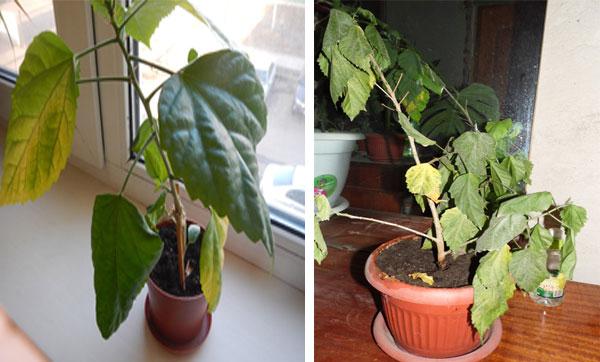

| External manifestations | The reasons | Remedies |
| The buds turn yellow and fall off without opening | The most likely cause is a lack of nutrients. In the same way, the plant reacts to a lack of moisture. | Fertilize the plant regularly; remember that it drinks more water during flowering. |
| Hibiscus leaves turn yellow and fall | There may be several reasons: drying out or waterlogging of the soil, drafts. | Observe agricultural practices. |
| Leaves wrinkle | This is how hibiscus reacts to too dry air. | Do not forget that the plant needs regular spraying. |
| Young leaves do not develop, are deformed | Most likely, your green pet was attacked by a spider mite. | Treat the bush with acaricides (Neoron, Fitoverm, Kleschevit). |
Subject to all agrotechnical rules, the plant develops a sufficiently strong immunity to independently cope with pests, fungal and bacterial infections.
Growing problems
If you notice the symptoms of the disease in time, you can quickly determine the cause and correct the situation. Now we will describe what this or that symptom means.
Hibiscus sheds unblown buds.
- insufficient watering;
- low room temperature;
- lack of nutrients.
Leaves wither.
- insufficient watering;
- excessive watering, and, as a result, decay of the root system.
Leaves dry and curl.
- insufficient air humidity.
Leaf fall.
- the presence of pests;
- the flower stands in a draft.
Leaves turn yellow and dry.
- watering is done with hard, most likely not settled chlorinated water;
- low room temperature.
The stems are elongated, the leaves lose their bright color, turn pale.
- lack of sunlight.
Indoor hibiscus does not bloom.
- too large a pot;
- insufficient lighting;
- lack of fertilizing;
- not trimmed.
There are sticky droplets on the back of the leaves.
- insect pests;
- the norm for some odorless varieties. This is how they attract insects for pollination.
On the obverse of the leaves there is a white bloom, which turns brown over time.
- Powdery mildew. Remove infected leaves. Treat the hibiscus with Bayleton or Fundazol.
Pinkish spots on the leaves.
- excess fertilizer;
- lack of light.
Pests
Spider mite.
- On the leaves there are yellowish spots, a small cobweb is noticeable. Spray the Chinese rose with insecticides such as Fitoverm or Derris. Avoid excessive dryness of the air, regularly spray the plant with water from a spray bottle. If spraying does not help, place the flower under an ultraviolet lamp.
Shield.
- Hard brown growths are observed on the back of the leaves along the veins. Adult scale insects are not afraid of chemicals and will have to be removed by hand. Then spray the plant with the insecticide solution. Repeat the procedure several times until you completely get rid of the scabbard.
Aphid.
- Young leaves and shoots wither and curl. Small insects are visible on them. Spray the plant with aphid remedy according to the instructions.
Trim / Support / Garter
Consider how and when to prune your home hibiscus flower.
The Chinese rose grows well and quickly. Therefore, in order to give the plant the desired shape - a bush or tree, it must be pruned.
The hibiscus pruning procedure is carried out before the start of the growth period. (February) or after flowering.
This formation is also important for abundant flowering. Branching increases, and accordingly, the number of leaf axils, in which buds are formed, also increases. The result is a real "rose bush"!

